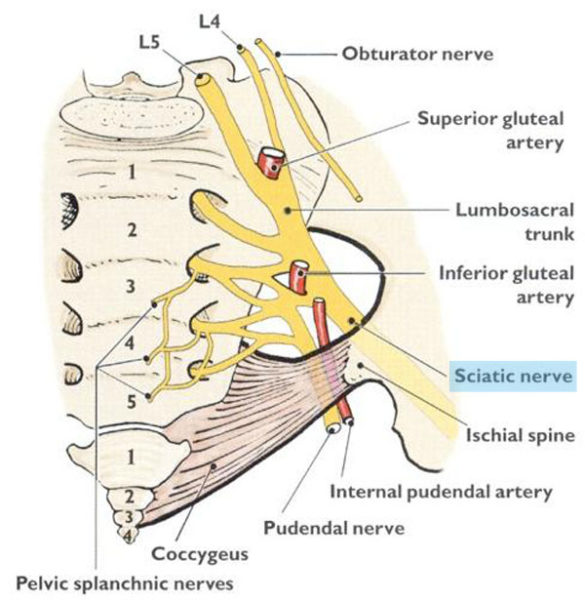Sciatica, nerve pain that travels from the low back or buttock down one or both legs, can feel irritating to excruciating. This type of pain can be constant to intermittent and is described as dull to pins and needles and affects 4 out of every 10 people at some point in their life. Many people use the term sciatica incorrectly. Sciatica is a symptom (like itching), it is not a diagnosis (like Parkinson’s disease). There are various causes of sciatica that include subluxations, or misaligned vertebrae in the lumbar or low back, herniated or bulging discs (tissue that acts as the shock absorber between vertebrae), tumors and illnesses such as diabetes.
The sciatic nerve is both the longest and the widest nerve in your body. It begins in the lower back as five separate nerves that extend from five different segments of the lumbar vertebra and sacrum – L4, L5, S1, S2, and S3. These nerves combine to form one large nerve that runs down through the buttocks and down the entire length of the leg. The sciatica nerve is responsible (directly or indirectly) for nearly all the sensation in your leg including the skin of the thigh and gluts. While sciatica is most often associated with pain, symptoms such as tingling, numbness, or muscle weakness can also occur.
There are various methods of treating this type of pain and include prescription or over-the-counter medications, physical therapy and chiropractic care. A study conducted in 2013 and published in the European Spine Journal reported the success rate of various treatment methods as follows: 20 percent success rate for physical therapy, 50 percent success rate for corticosteroid injections, and a whopping 72 percent success rate for chiropractic adjustments!
More than Pain Relief
When the pain of sciatica hits, it’s tempting to reach for the medication in hopes of dulling the pain as soon as possible. This method of treatment, however, does not address the root cause. If the pain is due to a misaligned vertebra, a dose of corticosteroids won’t put it back into place. It may decrease the associated inflammation and provide temporary relief, but it will not address the underlying cause.
A report in The Spine Journal on Chiropractic Manipulation in the Treatment of Acute Back Pain discussed a double-blind clinical study conducted on approximately 100 patients that were experiencing acute back pain and sciatica with disk protrusion. It was noted that “the active manipulation group had significantly greater relief from both local and radiating acute lower back pain, had fewer days with moderate-to-severe pain, and took fewer pain control drugs.”
Sciatica (sciatic nerve pain) is a symptom of an underlying condition. You’ll only start to get better once the underlying condition is identified. Chiropractors can help find and address the root cause of the problem.





